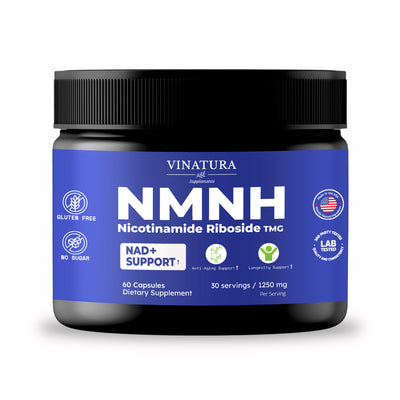
What is Intravenous NAD Therapy: Benefits, Side Effects & Precautions
NAD (Nicotinamide Adenine Dinucleotide) plays a crucial role in cellular energy production and overall well-being. As we age, NAD levels naturally decline, leading to a variety of health issues.
This has sparked interest in NAD therapies, including Intravenous NAD Therapy, which aims to replenish NAD levels directly in the bloodstream. This therapy is gaining popularity for its potential to combat aging, support brain health, and aid in addiction recovery.
Before exploring further, please read the disclaimer located at the end of this webpage.
Key Takeaways
- Intravenous NAD Therapy delivers NAD directly into the bloodstream.
- It may offer benefits such as age reversal, enhanced brain function, and support for addiction recovery.
- There are risks associated with the therapy, and it is important to consult a healthcare professional before proceeding.
What is Intravenous NAD Therapy? How Does it Work?
Intravenous NAD Therapy is a treatment where NAD (Nicotinamide Adenine Dinucleotide) is administered directly into the bloodstream through an IV drip. This method is particularly effective because it bypasses the digestive system, ensuring that NAD is rapidly absorbed and immediately available for use by the body’s cells.
How It Works:
- Direct Delivery
NAD is introduced directly into the bloodstream, which allows for quicker and more effective absorption compared to oral supplements. This means the cells can start using NAD almost immediately.
- Cellular Function Enhancement
NAD plays a crucial role in energy production at the cellular level. By boosting NAD levels, this therapy can enhance cellular function, leading to better energy levels and overall health.
- Metabolism Boost
NAD is also key in supporting metabolism. Increased NAD levels can aid in weight management, improve metabolic functions, and help with energy production.
Benefits of Intravenous NAD Therapy
Age Reversal
One of the most talked-about benefits of Intravenous NAD Therapy is its potential to reverse signs of aging. By replenishing NAD levels, the therapy may support cellular repair and regeneration, leading to improved skin elasticity, reduced wrinkles, and increased energy levels.
Addiction Recovery
Intravenous NAD Therapy is being used as an adjunct treatment for addiction recovery. NAD helps repair brain cells damaged by substance abuse and may reduce withdrawal symptoms, making it easier for patients to overcome their addictions.
Brain Health

NAD is essential for maintaining healthy brain function. By improving NAD levels, the therapy may enhance cognitive function, improve memory, and protect against neurodegenerative diseases like Alzheimer’s.
Metabolic Support
NAD plays a vital role in metabolism. Intravenous NAD Therapy may help improve metabolic functions, support weight management, and increase overall energy levels.
Muscle Function and Athletic Performance
NAD boosts energy production in muscle cells, enhancing endurance and muscle function. This makes it particularly useful for athletes or those looking to improve their physical performance.
Anxiety and Depression Management
NAD’s impact on brain health extends to mental well-being. By supporting healthy brain function and reducing inflammation, NAD may help alleviate symptoms of anxiety and depression.
A study published in Molecular Psychiatry highlights NAD's potential in modulating stress responses and improving mental health outcomes in individuals with anxiety and depression [1].
Energy and Fatigue Reduction
NAD is a key factor in mitochondrial energy production, which means it can help reduce fatigue and improve overall energy levels. By enhancing mitochondrial function, NAD ensures that cells have the energy they need to function optimally.
Research Insight: A study in Aging Cells found that NAD supplementation improves mitochondrial function, which can increase energy levels and reduce fatigue [2].
Pros and Cons of Intravenous NAD Therapy Compared to Other Methods
| Method | Pros | Cons |
| Intravenous NAD Therapy | Rapid absorption, immediate effects | Expensive, requires medical supervision |
| Oral Supplements | Easy to administer, more affordable | Lower absorption rate, slower effects |
| NAD Injections | Direct delivery to specific areas, higher effectiveness in targeted therapy | Painful, requires frequent administration |
| Topical NAD | Non-invasive, easy to use, promotes skin health | Limited absorption, primarily benefits skin health |
| NAD Nasal Sprays | Rapid absorption, non-invasive, potential cognitive benefits | Limited research, effects may vary |
| NAD Transdermal Patches | Slow and steady release, convenient for long-term use | Limited research, may not provide immediate effects |
Risks of Intravenous NAD Therapy
Intravenous NAD Therapy presents various potential benefits, but like any medical treatment, NAD is not without risks. Understanding these risks is essential to making an informed decision.
Common Risks:
- Nausea

Some patients may experience nausea during or after the therapy. This is typically mild and can be managed with proper hydration and by adjusting the infusion rate.
- Headaches
Another common side effect is headaches, which may occur due to the body's response to increased NAD levels. These headaches are usually temporary and can be alleviated with rest and hydration.
- Allergic Reactions
Although rare, allergic reactions can occur. Symptoms might include swelling, itching, or difficulty breathing. Immediate medical attention is required if these symptoms arise.
What Need to Know When Choosing Intravenous NAD Therapy?
Before starting Intravenous NAD (IV NAD) therapy, it's important to consider the following:
Consult a Healthcare Provider
Always speak with a healthcare professional to determine if IV NAD therapy is suitable for you, especially if you have pre-existing conditions or are on medication.
Understand the Potential Side Effects
Be aware of possible side effects like nausea, headaches, fatigue, and irritation at the injection site. These are typically mild but should be considered.
Check Practitioner Credentials

Ensure that the treatment is administered by a qualified and experienced practitioner to minimize risks.
Weigh the Benefits and Risk
IV NAD therapy has potential benefits, such as improved brain health and metabolism. However, it also has risks and is not FDA-approved for specific conditions.
Consider Costs
This therapy can be expensive and may not be covered by insurance. Be sure to understand all costs before proceeding.
Research the Facility
Choose a reputable clinic with good reviews and transparent practices to ensure safe and effective treatment.
By considering these factors, you can make an informed decision about whether IV NAD therapy is the right choice for you.
How to Prepare for NAD+ IV Therapy
Before undergoing NAD+ IV therapy, consult your healthcare provider for specific instructions. Generally, here’s how you can prepare:
Stay Hydrated

Drink plenty of water before your session. Hydration helps improve your veins’ accessibility and reduces the risk of nausea.
Fasting
Some providers may recommend a light meal or fasting a few hours before therapy to minimize potential side effects.
Comfortable Clothing
Wear loose, comfortable clothing to make it easier to administer the IV and relax during the session.
What to Expect During NAD+ IV Therapy
During NAD+ IV therapy:
Administration
NAD+ is given through an IV drip, usually over 1 to 4 hours, depending on the dosage.
Setting
Patients typically sit in a comfortable chair in a calm environment.
Sensations
Some may feel a warm sensation or mild discomfort at the injection site, which is normal and usually subsides quickly.
Recovery of NAD+ IV Therapy
Recovery from NAD+ IV therapy is usually quick:
Resume Normal Activities
Most patients can return to their daily routine right after the session.
Stay Hydrated
Continue to drink plenty of water to help your body process the therapy.
Avoid Strenuous Activities
Rest and avoid heavy exercise for the remainder of the day to allow your body to recover fully.
Other Types of NAD Therapy
While Intravenous NAD Therapy is one of the most direct and effective methods, there are several other ways to administer NAD that might better suit different needs and preferences. Each method has its advantages and limitations, and understanding these can help you choose the best option for your situation.
- Supplements
These are the most accessible forms of NAD therapy, typically available in capsule or tablet form. They are easy to take daily, making them convenient for those who prefer a non-invasive method. However, the absorption rate of NAD through the digestive system is significantly lower than other methods, which may reduce their effectiveness.
While oral supplements can help maintain NAD levels, they are less effective at rapidly increasing NAD concentrations compared to IV or injection methods.
- Injections
This method involves directly injecting NAD into specific areas of the body, often targeting regions where enhanced cellular repair or rejuvenation is desired. NAD injections offer a more targeted approach compared to oral supplements and can be more effective in achieving higher local concentrations of NAD. However, frequent administration is often required, which can be inconvenient and sometimes uncomfortable.
According to research published in Molecular Psychiatry, NAD injections have shown the potential to improve cognitive function and aid in addiction recovery, though they require precise administration [3].
- Topical Applications
These products are applied directly to the skin and are primarily used for their anti-aging properties. The idea is that NAD can be absorbed through the skin to promote cellular repair and rejuvenation. However, the absorption rate through the skin is limited, and the benefits are usually restricted to the skin's surface rather than systemic effects.
While topical NAD can improve skin health, it is less effective in providing the systemic benefits that other methods offer.
- NAD Nasal Sprays
This method is relatively new and involves administering NAD directly through the nasal passage. The nasal cavity has a rich blood supply, allowing for rapid absorption of NAD into the bloodstream. This method is convenient and non-invasive, with the potential for quicker results compared to oral supplements.
NAD nasal sprays may offer an efficient way to deliver NAD to the brain, potentially benefiting cognitive functions and mood regulation.
- NAD Patches
These patches deliver NAD through the skin over a sustained period. The slow and steady release of NAD can help maintain consistent levels in the bloodstream, which might be beneficial for long-term therapy. However, the effectiveness of NAD patches is still under research, and they may not provide the immediate boost that IVs or injections offer.
While transdermal patches are a promising delivery method, more studies are needed to confirm their efficacy in delivering NAD at therapeutic levels.
Is NAD IV Therapy FDA Approved?
As of now, NAD IV Therapy is not FDA-approved. It is considered an alternative treatment, and its safety and efficacy are still under investigation. It’s important to proceed with caution and seek treatments from reputable providers.
Frequently Asked Questions
Is Intravenous NAD Therapy Safe?
While generally considered safe, Intravenous NAD Therapy should only be done under medical supervision. Risks include nausea, headaches, and allergic reactions.
How Long Does NAD IV Therapy Last?
The effects of NAD IV Therapy can last from several days to a few weeks, depending on the individual’s health and the specific goals of the treatment.
How Often Do You Need NAD IV Therapy?
The frequency of NAD IV Therapy depends on the condition being treated. Some individuals may require weekly sessions, while others may only need maintenance therapy every few months.
Conclusion
Intravenous NAD Therapy offers promising benefits for age reversal, brain health, addiction recovery, and metabolic support. However, it is important to weigh the risks and consult with a healthcare provider before starting treatment.
By understanding how the therapy works and preparing accordingly, individuals can maximize the potential benefits while minimizing the risks.
References
- [1] Smith, D J, et al. “Genome-Wide Analysis of over 106 000 Individuals Identifies 9 Neuroticism-Associated Loci.” Molecular Psychiatry, vol. 21, no. 6, 12 Apr. 2016, pp. 749–757, www.nature.com/articles/mp201649, https://doi.org/10.1038/mp.2016.49. Accessed 8 Sept. 2024.
- [2] Ji, Juan, et al. “Antagonizing Peroxisome Proliferator‐Activated Receptor γ Facilitates M1‐To‐M2 Shift of Microglia by Enhancing Autophagy via the LKB1–AMPK Signaling Pathway.” Aging Cell, vol. 17, no. 4, 8 May 2018, onlinelibrary.wiley.com/doi/full/10.1111/acel.12774, https://doi.org/10.1111/acel.12774. Accessed 8 Sept. 2024.
- [3] Li, W, et al. “Characterization and Transplantation of Enteric Neural Crest Cells from Human Induced Pluripotent Stem Cells.” Molecular Psychiatry, vol. 23, no. 3, 25 Oct. 2016, pp. 499–508, www.nature.com/articles/mp2016191, https://doi.org/10.1038/mp.2016.191. Accessed 27 Aug. 2024.
Author

Product Disclaimer
The dietary supplement products mentioned on this website are formulated based on scientific research and adhere to FDA guidelines for dietary supplements. However, the content of the articles has not been evaluated by the Food and Drug Administration (FDA) and is not intended to promote or endorse any specific product. Any products sold on this website are not intended to diagnose, treat, cure, or prevent any disease.
Opinions and Endorsements
Any claims, statements, or opinions expressed in the articles are those of the author(s) and do not necessarily reflect the views or opinions of the manufacturers of the dietary supplement products. The products sold on this website are separate from the content of the articles and are not directly endorsed or associated with the information presented here.
Liability Disclaimer
The author(s) of the articles, website, and manufacturers of the dietary supplement products do not assume any liability for any potential consequences arising from the use of the information provided in the articles. It is recommended that individuals consult with a qualified healthcare professional before making any dietary or lifestyle changes, including the use of dietary supplements.
Product Usage
Please refer to the product labels and packaging for specific usage instructions and guidelines for the dietary supplement products sold on this website.
Customer Support
For any concerns or questions regarding the dietary supplement products, please contact our customer support team, who will be more than happy to assist you.





Leave a Comment
Be the first to comment.
What do you think?